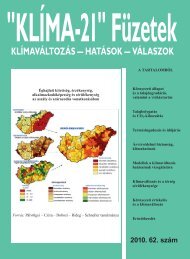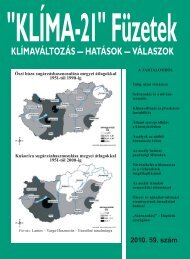KLÃMA-21 Füzetek 61. szám - VAHAVA Hálózat
KLÃMA-21 Füzetek 61. szám - VAHAVA Hálózat
KLÃMA-21 Füzetek 61. szám - VAHAVA Hálózat
You also want an ePaper? Increase the reach of your titles
YUMPU automatically turns print PDFs into web optimized ePapers that Google loves.
120 „KLÍMA-<strong>21</strong>” FÜZETEK: KLÍMAVÁLTOZÁS – HATÁSOK – VÁLASZOK<br />
(2006): Linking global warming to amphibian declines through its effects on female body<br />
condition and survivorship. Oecologia. 151(1): 125-131. pp. (35) READING, C. J. – CLARKE, R.<br />
T. (1995): The effects of density, rainfall and environmental temperature on body condition<br />
and fecundity in the common toad, Bufo bufo. Oecologia. 102: 453-459. pp. (36) READING, C.<br />
J. – CLARKE, R. T. (1999): Impacts of climate and density on the duration of the tadpole stage<br />
of the common toad, Bufo bufo. Oecologia. 1<strong>21</strong>: 310-315. pp. (37) RÖDDER, D. – SCHULTE, U.<br />
(2010): Amphibien und Reptilien im anthropogenen Klimawandel: Was wissen wir und was<br />
erwarten wir Zeitschrift für Feldherpetologie. 17: 1-22. pp. (38) SNODGRASS, J. W. – BRYANT,<br />
A. L. JR. – BURGER, J. (2000): Development of expectations of larval amphibian assemblage<br />
structure in southeastern depression wetlands. Ecological Applications. 10: 1<strong>21</strong>9-1229. pp.<br />
(39) STALLARD, R. F. (2001): Possible environmental factors underlying amphibian decline in<br />
Eastern Puerto Rico: analysis of U.S. government data archives. Conservation Biology. 15(4):<br />
943-953. pp. (40) STEWART, M. (1995): Climate Driven Population Fluctuations in Rain Forest<br />
Frogs. Journal of Herpetology. 29(3): 437-446. pp. (41) TEIXEIRA, J. – ARTNZEN, J. W. (2002):<br />
Potential impact of climate warming on the distribution of the Golden-striped salamander,<br />
Chioglossa lusitanica, on the Iberian Peninsula. Biodiversity and Conservation. 11: <strong>21</strong>67-<strong>21</strong>76.<br />
pp. (42) TERHIVUO, J. (1988): Phenology of spawning for the common frog (Rana temporaria<br />
L.) in Finland from 1846 to 1986. Annales Zoologici Fennici. 25: 165–175. pp. (43) THOMAS, C.<br />
D. – CAMERON, A. – GREEN, R. E. – BAKKENES, M. – BEAUMONT, L. J. – COLLINGHAM, Y. C. –<br />
ERASMUS, B. F. N. – DE SIQUEIRA, M. F. – GRAINGER, A. – HANNAH, L. – HUGHES, L. – HUNTLEY,<br />
B. – VAN JAARSVELD, A. S. – MIGLEY, G. F. – MILES, L. – ORTEGA-HUERTA, M. A. – PETERSON, A.<br />
T. – PHILLIPS, O. L. – WILLIAMS, S. E. (2004): Extinction risk from climate change. Nature.<br />
427: 145-148. pp. (44) TRYJANOWSKI, P. – MARIUSZ, R. – SPARKS, T. (2003): Changes in spawning<br />
dates of common frogs and common toads in western Poland in 1978–2002. Annales<br />
Zoologica Fennici. 40: 459–464. pp. (45) TRYJANOWSKI, P. – SPARKS, T. – RYBACKI, M. – BER-<br />
GER, L. (2006): Is body size of the water frog Rana esculenta complex responding to climate<br />
change Naturwissenschaften. 93(3): 110-113. pp. (46) WEYGOLDT, P. (1989): Changes in the<br />
composition of mountain stream frog communities in the Atlantic Mountains of Brasil: frogs<br />
as indicators of environmental deterioration Studies of Neotropical Fauna and Environment.<br />
24: 249-255. pp. (47) WELLBORN, G. A. – SKELLY, D. K. – WERNER, E. E. (1996): Mechanisms<br />
creating community structure across a freshwater habitat gradient. Annual Review of Ecology<br />
and Systematics. 27: 337-363. pp.






